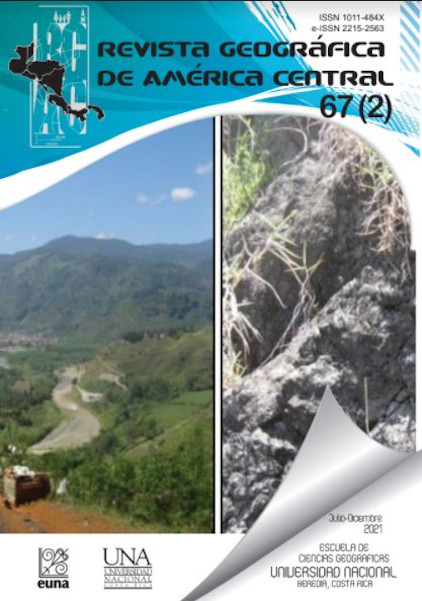Aplicación del método Persistent Scatterer Interferometry (PSI) en la ciudad de Limón, Costa Rica
DOI:
https://doi.org/10.15359/rgac.67-2.1Palabras clave:
InSAR, PSI, deformaciónResumen
El objetivo de esta investigación fue aplicar el método Persistent Scatterer Interferometry (PSI) en la ciudad de Limón, Costa Rica, con el fin de estimar la velocidad de deformación de la superficie. La investigación es de tipo descriptiva y el enfoque que se utilizó es el uso de imágenes de Radar de la misión Sentinel-1, las cuales fueron preprocesadas en el programa SNAP de la Agencia Espacial Europea y luego usando el programa StaMPS se estimó la velocidad en la línea de vista (LOS) y series de tiempo. Como resultado se tiene que las velocidades estimadas en LOS están en el rango de -11 mm/yr hasta +20 mm/yr. Se concluye que el método tiene un potencial para ser usado en Costa Rica en investigaciones que requieren conocer información sobre la dinámica de la superficie y en la cual no se cuenta con información provista por otros métodos como los GNSS.
Referencias
Alvarado, G. & Cárdenas, G. (2016). Chapter 3 Geology, Tectonics, and Geomorphology of Costa Rica: A Natural History Approach. En M. Kappelle, Costa Rican Ecosystems (p. 744). London.
Balzter, H. (2001). Forest mapping and monitoring with interferometric synthetic aperture radar (InSAR). Progress in physical geography, 25(2), pp. 159-177.
Barrantes-Castillo, G., Arozarena-Llopis, I., Sandoval-Murillo, L. F., & Valverde-Calderón, J. F. (2019). Playas críticas por erosión costera en el caribe sur de Costa Rica, durante el periodo 2005-2016. Revista Geográfica de América Central, 1(64), pp. 95-122. https://doi.org/10.15359/rgac.64-1.4
Campbell, J. B. & Wynne, R. H. (2011). Introduction to remote sensing. Guilford Press. Chicago Press.
Cho, B. L., Kong, Y. K., Park, H. G., & Kim, Y. S. (2006). Automobile-based SAR/InSAR system for ground experiments. IEEE Geoscience and Remote Sensing Letters, 3(3), pp. 401-405.
Crosetto, M., Monserrat, O., Cuevas-González, M., Devanthéry, N., & Crippa, B. (2016). Persistent scatterer interferometry: A review. ISPRS Journal of Photogrammetry and Remote Sensing, 115, pp. 78-89.
Delgado-Blasco, J. M., Foumelis, M., Stewart, C., & Hooper, A. (2019). Measuring urban subsidence in the rome metropolitan area (italy) with sentinel-1 snap-stamps persistent scatterer interferometry. Remote Sensing, 11(2), p. 129. https://doi.org/10.3390/rs11020129
Denyer, P., Arias, O., & Personius., S. (1994). Efectos tectonicos del terremoto de Limon, Costa Rica. Rev. Geol. Amer. Central, Volumen especial, pp. 39-52.
Haghighi, M., & Motagh, M. (2017). Sentinel-1 InSAR over Germany: Large-scale interferometry, atmospheric effects, and ground deformation mapping. ZfV: Zeitschrift für Geodäsie, Geoinformation und Landmanagement, 2017(4), 245-256.
Hanssen, R.F. (2001). Radar interferometry: data interpretation and error analysis (Vol.2). Springer Science & Business Media.
Homer, J., Longstaff, I. D., & Callaghan, G. (1996). High resolution 3-D SAR via multi-baseline interferometry. In IGARSS’96. 1996 International Geoscience and Remote Sensing Symposium (Vol. 1, pp. 796-798). IEEE.
Hooper, A. (2010). A statistical-cost approach to unwrapping the phase of InSAR time series. In Proceedings of the International Workshop on ERS SAR Interferometry, Frascati, Italy (Vol. 30).
Hooper, A., Bekaert, D., & Spaans, K. (2010). StaMPS/MTI manual. Delft Institute of Earth Observation and Space Systems Delft University of Technology, Kluyverweg, 1, p. 2629.
Hooper, A., Segall, P., & Zebker, H. (2007). Persistent scatterer InSAR for crustal deformation analysis, with application to Volcán Alcedo, Galápagos. Journal of Geophysical Research, 112(B07407), p. 19.
Höser, Thorsten. (2018). Analysing the Capabilities and Limitations of InSAR using Sentinel-1 Data for Landslide Detection and Monitoring. https://doi.org/10.13140/rg.2.2.35085.59362
Hu, J., Li, Z. W., Ding, X. L., Zhu, J. J., Zhang, L., & Sun, Q. (2014). Resolving three-dimensional surface displacements from InSAR measurements: A review. Earth-Science Reviews, 133, pp. 1-17.
Instituto Meteorológico Nacional [IMN]. (2017). Clima de Costa Rica: el clima y las regiones climáticas de Costa Rica. Recuperado el 07 de noviembre de 2017, de Instituto Meteorológico Nacional: https://www.imn.ac.cr
Kampes, B. M. (2005). Displacement Parameter Estimation using Permanent Scatterer Interferometry, Ph.D. thesis, Delft University of Technology.
Kerle, N., Janssen, L. L., & Huurneman, G. C. (2004). Principles of remote sensing. ITC, Educational textbook series, 2, p. 250.
Ministerio de Planificación Nacional y Política Económica. [MIDEPLAN]. (2018). Área de Análisis del Desarrollo. Índice de desarrollo social 2017 / Ministerio de Planificación Nacional y Política Económica. -- San José, CR: MIDEPLAN, 2018.
Montero, W., Pardo, M., Ponce, L., Rojas, W., & Fernández, M. (1994). Evento principal y replicas importantes del terremoto de Limón. Revista Geológica de América Central. Vol. espec. Terremoto de Limón, pp. 93-102.
Morera-Beita, C. & Miranda-Álvarez, P. (2016). De la geografía del turismo al análisis territorial del turismo: el rastro en Costa Rica. Revista Geográfica de América Central, 1(54), 15-43. https://doi.org/10.15359/rgac.1-54.1
Municipalidad de Limón. (2019). Municipalidad del Cantón Central de Limón. Obtenido de Historia: http://www.municlimon.go.cr/index.php/mn-conozcanos/mn-micanton/mn-historiacanton
NASA. (2014). EcoSAR. Recuperado el 29 de Enero de 2019, de https://ecosar.gsfc.nasa.gov/campaigns/costa-rica
Osmanoğlu, B., Dixon, T. H., Wdowinski, S., Cabral-Cano, E., & Jiang, Y. (2011). Mexico City subsidence observed with persistent scatterer InSAR. International Journal of Applied Earth Observation and Geoinformation, 13(1), pp. 1-12.
Sajinkumar, K. S., Bincy, H. S., Bouali, E. H., Oommen, T., Vishnu, C. L., Anilkumar, Y. & Keerthy, S. (2020). Picturing beach erosion and deposition trends using PSInSAR: an example from the non-barred southern west coast of India. Wetlands Ecology and Management, pp. 1-14.
Samieie-Esfahany, S., Hanssen, R., van Thienen-Visser, K., & Muntendam-Bos, A. (2009). On the effect of horizontal deformation on InSAR subsidence estimates. In Proceedings of the Fringe 2009 Workshop, Frascati, Italy (Vol. 30).
Smith, L. C. (2002). Emerging applications of interferometric synthetic aperture radar (InSAR) in geomorphology and hydrology. Annals of the Association of American Geographers, 92(3), pp. 385-398.
Soergel, U. (2010). Review of radar remote sensing on urban areas. In Radar remote sensing of urban areas. Springer, Dordrecht, pp. 1-47.
Trejos, B. & Chiang, L. H. N. (2009). Local economic linkages to community based tourism in rural Costa Rica. Singapore journal of tropical geography, 30(3), pp. 373-387.
U.S. Geological Survey. (2019). USGS science for a changing world. Obtenido de Mapping, Remote Sensing, and Geospatial Data: https://www.usgs.gov/faqs/what-remote-sensing-and-what-it-used?qt-news_science_products=0#qt-news_science_products
Uys, Duan. (2016). InSAR: an introduction. Preview. 182, 43-48 https://doi.org/10.1071/PVv2016n182p43
Valverde-Calderón, J. (2020). Estudio del efecto de un terremoto sobre un marco geodésico de referencia. Uniciencia, 34 (1), 1-2019, pp. 1-19. http://dx.doi.org/10.15359/ru.34-1.1
Yhokha, A., Goswami, P.K., Chang, CP. et al. (2018). Application of Persistent Scatterer Interferometry (PSI) in monitoring slope movements in Nainital, Uttarakhand Lesser Himalaya, India. J Earth Syst Sci 127, 6 https://doi.org/10.1007/s12040-017-0907-y
Zebker, H., & Villasenor, J. (1992). Decorrelation in interferometric radar echoes. IEEE Transactions on Geoscience and Remote Sensing 30 (5), pp. 950-959.
Publicado
Cómo citar
Número
Sección
Licencia
Política propuesta para Revistas que ofrecen Acceso Abierto
Los autores que publican en esta revista están de acuerdo con los siguientes términos:
a. Los autores conservan los derechos de autor y garantizan a la revista el derecho de ser la primera publicación del trabajo, bajo la Licencia https://creativecommons.org/licenses/by-nc-sa/4.0/deed.es, que permite a otros compartir con un reconocimiento de la autoría del trabajo y la publicación inicial en esta revista.
b. Los autores pueden establecer por separado acuerdos adicionales para la distribución no exclusiva de la versión de la obra publicada en la revista (por ejemplo, situarlo en un repositorio institucional o publicarlo en un libro), con un reconocimiento de su publicación inicial en esta revista. Esos acuerdos adicionales deben respetar los términos de la licencia: es decir: no involucrar fines de lucro y compartir con la misma licencia.
c. Se anima a los autores a archivar el post-print o versión de editor/PDF en repositorios de acceso abierto.







 REVGEO se encuentra bajo la licencia https://creativecommons.org/licenses/by-nc-sa/4.0/deed.es
REVGEO se encuentra bajo la licencia https://creativecommons.org/licenses/by-nc-sa/4.0/deed.es
.svg_4.png)

_(1).png)
_(1)_(1)_(1)_1.png)
(2)(1)(1)(1).png)
